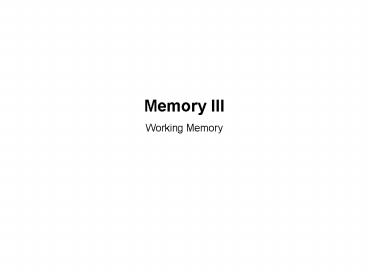Memory III Working Memory - PowerPoint PPT Presentation
1 / 23
Title:
Memory III Working Memory
Description:
Memory III Working Memory – PowerPoint PPT presentation
Number of Views:114
Avg rating:3.0/5.0
Title: Memory III Working Memory
1
Memory IIIWorking Memory
2
Atkinson Shiffrin (1968) Model of Memory
3
Visual Sensory Store
- It appears that our visual system is able to hold
a great deal of information but that if we do not
attend to this information it will be rapidly
lost. - Sperling (1960)
- Presented array consisting of three rows of four
letters - Subjects were cued to report part of display
Demo athttp//www.dualtask.org/
X M R J C N K P V F L B
4
Visual Sensory Memory
- Vary the delay of cue in partial report
- After one second, performance reached asymptote
Mean number of words reported
Delay of cue (in seconds)
5
Iconic Memory
- Sperlings experiments indicate the existence of
a brief visual sensory memory known as iconic
memory or iconic store - Information decays rapidly unless attention
transfers items to short-term memory - Analogous auditory store echoic store
6
Atkinson Shiffrin (1968) Model of Memory
- Short-term memory (STM) is a limited capacity
store for information -- place to rehearse new
information from sensory buffers - Items need to be rehearsed in short-term memory
before entering long-term memory (LTM) - Probability of encoding in LTM directly related
to time in STM
7
a memory test...
- TABLE
CANDLE
MAPLE
SUBWAY
PENCIL
COFFEE
TOWEL
SOFTBALL
CURTAIN
PLAYER
KITTEN
DOORKNOB
FOLDER
CONCRETE
RAILROAD
DOCTOR
SUNSHINE
LETTER
TURKEY
HAMMER
8
Serial Position Effects
nodistractor task
distractor task
- In free recall, more items are recalled from
start of list (primacy effect) and end of the
list (recency effect) - Distractor task (e.g. counting) after last item
removes recency effect
9
Serial Position Effects
- Explanation from Atkinson and Shiffrin (1968)
model - Early items can be rehearsed more often
- ? more likely to be transferred to long-term
memory - Last items of list are still in short-term memory
(with no distractor task) - ? they can be read out easily from short-term
memory
10
Evaluating Modal Memory Model
- Pro provides good quantitative accounts of many
findings - Contra
- assumption that all information must go through
STM is probably wrong - Model proposes one kind of STM but evidence
suggests we have multiple kinds of STM stores
11
Baddeleys working memory model
- Baddeley proposed replacing unitary short-term
store with working memory model with multiple
components - Phonological loop
- Visuo-spatial sketchpad
- Central executive (ignore the episodic buffer)
Baddeley and Hitch (1974) Baddeley (1986)
12
Phonological Loop(a.k.a. articulatory loop)
- Stores a limited number of sounds number of
words is limited by pronunciation time, not
number of items - Experiment
- Word length effect mean number of words
recalled in order (list 1 ? 4.2 words list 2 ?
2.8 words)
LIST 1 Burma Greece Tibet Iceland Malta Laos
LIST 2 Switzerland Nicaragua Afghanistan
Venezuela Philippines Madagascar
13
Reading rate determines serial recall
- Reading rate seems to determine recall
performance - Phonological loop stores 1.5 - 2 seconds worth of
words
14
Working memory and Language Differences
- Different languages have different syllables per
digit - Therefore, recall for numbers should be different
across languages - E.g. memory for English number sequences is
better than Spanish or Arabic sequences
(Naveh-Benjamin Ayres, 1986)
15
Two routes to phonological loop
Articulatory control process
Visualpresentation
Speech code
Phonological loop
Auditorypresentation
- Articulatory control process converts visually
presented words into a speech code - Articulatory suppression (e.g. saying the all
the time) - disrupts phonological loop
- diminishes word length effect with visual
presentation (visiospatial sketchpad takes over)
16
Immediate word recall as a function of modality
of presentation (visual vs. auditory), presence
vs. absence of articulatory suppression, and word
length.
Baddeley et al. (1975).
17
Neural Network Models of Memory
- Long-term memory
- weight-based memory the memory representation
takes its form in the strength or weight of
neural connections - Short-term memory
- activity-based memory, in which information is
retained as a sustained or persistent pattern of
activity in specific neural populations
18
Weight-based memory
- Long-term associative memories can be formed by
Hebbian learning changes in synaptic weights
between neurons
Donald O. Hebb
19
Working Memory and Prefrontal Cortex
20
Delayed Match to Sample Tasks
- Correct response requires keeping location of
food in mind. - Monkeys and humans w/lesions of PFC fail these
tasks. - Infants younger than 12 months also fail
versions of these tasks.
21
Delayed Saccade Task(Goldman-Rakic)
22
Neural Network Model
- http//info.med.yale.edu/neurobio/xjwang/movie/alb
ert/spatial_wm.html
23
Role of PFC in Memory Encoding
- If fMRI activity at encoding is back-sorted
according to whether words are subsequently
remembered or forgotten, then lower left VLPFC
(and hippocampus) activation predicts later
forgetting





















![⚡[PDF]✔ A TREASURE HUNT ADVENTURE III: SOLVE PUZZLES AND CLUES TO FIND LOCATION PowerPoint PPT Presentation](https://s3.amazonaws.com/images.powershow.com/10072864.th0.jpg?_=20240704107)









